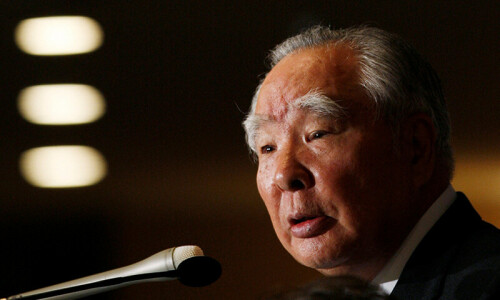TAGAB VALLEY: Hundreds of Taliban fighters had massed just 100 kilometers north of Kabul in this isolated valley, where militants trained suicide bombers who launched a deadly wave of attacks in the Afghan capital this autumn.
Military officials feared a bloody winter campaign in Kabul, an extension of an unprecedented bombing spree that’s seen 115 suicide attacks across Afghanistan this year.
But the capital is now quiet. While the southern city of Kandahar reels from a recent series of suicide attacks, Kabul hasn’t seen such a bombing in over two months.
US Special Forces say a little-publicised Afghan-US operation in the Tagab Valley north of the city busted three suicide training compounds and scattered hundreds of Taliban fighters.
“There was definitely the potential for Tagab to provide that launch board, if you will, for additional attacks,” US Army Special Forces Lt-Col Lynn Ashley told The Associated Press this week. “A threat to Bagram, a threat to Kabul,” he said, referring to the main US base in Afghanistan.
Between 300 and 500 militants had been able to gather so close to the capital partly because of the region’s rough terrain, Ashley said. Minor operations had been conducted but never a full-scale push, allowing fighters to create suicide training compounds.
But a weeklong operation early last month scattered the militants and has brought security to the valley. Abdul Satar Murad, the governor of Kapisa province, said about 20 fighters-- some of whom had come from Pakistan-- were killed and that the rest left the region.
After launching five suicide attacks in Kabul during the first eight months of the year, fighters had stepped up their offensive, detonating eight suicide bombs in September and October, said Major Dominic Whyte, a spokesman for Nato’s International Security Assistance Force.
Two attacks in particular set residents on edge and raised the spectre of Baghdad-type violence: an attack Sept 8 near the US Embassy that killed 16 people, including two US soldiers, and a bombing near the Interior Ministry Sept 30 that killed 12 Afghans and wounded 40.
The violence has, at least for now, subsided in Kabul-- even as militants have recently launched seven suicide attacks within 11 days this month in the Kandahar region, the former seat of the Taliban militia that was ousted from power in late 2001 but has bounced back this year, threatening Afghanistan’s new democracy.
“What we had predicted was the intensity of suicide bombings was going to pick up throughout the winter months in Kabul,” Ashley said in an interview at the US base at Bagram. “What we think is that by us denying them that safe haven over the winter that it will definitely lesson their ability to mass when they come out in the spring like they normally do.”
About 250 US special and conventional forces along with more than 800 Afghan police and army personnel launched the offensive in early November.
Murad, the governor, was closely involved in its planning and execution, fuelling its success and cutting down on civilian casualties, Ashley said. As part of a hearts and minds campaign, medics gave free care to hundreds of Afghans and passed out food supplies.
The US has since built a small military base on a high plateau at the top of a long, windy dirt road on the valley’s northern edge. US soldiers on a security patrol there last week marvelled at how much work has been done on the road recently.
The $3 million road project had been delayed because of the security threat. Other projects have benefited from the increased security, including a new cell phone tower, Ashley said.
Murad said there have been no attacks on police posts in Kapisa since the operation.
“Tagab was a key base for the Taliban, where they made homemade bombs and gave suicide attackers training,” Murad said. “Coalition forces and the Afghan army and police have regular patrols now, and I'm sure the Taliban will not come back.”
The Afghan-US cooperation during the operation was hailed as a model of success by Gen David Richards, the top Nato general in Afghanistan, and by US Lt-Gen Karl Eikenberry.
Afghan officials “needed to take ownership and they needed to do most of the piece to liberate the valley,” Ashley said. “Our special forces teams enabled that to happen through their expertise and through close air support.”Jittery nerves remain in Kabul after the fall bombings, though they have calmed somewhat. Residents are aware the attacks could start again.
“The situation has improved, but still we are afraid because the enemy, whenever it finds an opportunity, it will do something,” said Faruz Ahmad, a 44-year-old money changer.—AP













































Dear visitor, the comments section is undergoing an overhaul and will return soon.